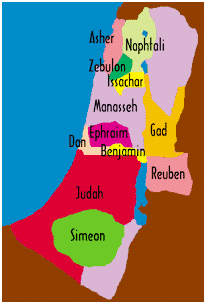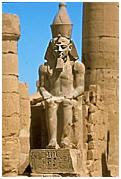有没有关于以色列的族长,雅各儿子们的考古学证据?
作者:Dr.
Bryant G. Wood of
Associates for
Biblical Research
张逸萍译自:
|
|
|
|
以色列十二支派
(Films
for Christ.
提供的地图) |
有各种考古发现,支持圣经所讲,关于雅各的12个儿子,和以色列支派后来的记载。
但——必判断他的民
见:创四十九16
但,是雅各的第五个儿子,是拉结的使女辟拉的第一个儿子(创三十1-6)。在士师时代,但支派从原先分配给他们的,地中海沿岸的之地,迁移到拉亿,起名为但(士十八)。[1]
拉亿 /
但的遗址,自1966年以来,由Avraham
Biran领导,代表以色列文物局,一直在挖掘。
但城最有名的地方是:这是北国第一位王耶罗波安,为了脱离南国,而设立拜金牛犊的丘坛地点之一。
耶罗波安王就筹画定妥,铸造了两个金牛犊,对众民说,以色列人哪,你们上耶路撒冷去,实在是难,这就是领你们出埃及地的神。他就把牛犊一只安在伯特利,一只安在但。
—王上十二28-29
这个丘坛已被Biran发现和挖掘(Biran
1976)。但的丘坛不仅在以色列时期使用,而且继续到罗马统治时期,仍然是宗教中心。
1977年,出现了一个非常重要的希腊化时期(主前3
- 2世纪)发现:在丘坛以南17米处,发现了一个专门提到但的碑文(Biran
1981)。这是第一次,圣经地名,在一个古老的铭文上找到,而且是雅各儿子之一的名字。
迦得——必被敌军追逼
见:创四十九19
迦得是雅各的第七个儿子,是利拉的婢女悉帕的第一个儿子。迦得支派占领了外约旦的中央地区(书十三24-28)。
在约旦Dhibon发现的,可追溯到主前9世纪的,著名米沙(Mesha)碑文,提到迦得支派。[2]摩押王米沙说∶“迦得人自古就住在亚他录地。”(Lemaire,1994: 33,第10行)。
[3]亚设——必出肥美的粮食
见:创四十九20
许多学者认为,在埃及文献中的名字「'Isr」,就是以色列支派亚设这名字(例如,Aharoni
1979∶179,183; Hadley 1992∶482)。不过,似乎不是这样。因此,我们根据从其他来源所得的资料,提出下面的意见。
最早提到「'Isr」这名字的,是主前13世纪,Seti一世所征服的人民名单上(Simons
1937:147, List XVII, no. 4)。
|
|
|
|
法老拉美西斯二世 (Films for Christ.提供) |
这个名字也出现在拉美西斯
(Rameses)二世碑文上几次(主前1279-1212年)也是在被征服的人民的名单中(Gauthier 1925:105; Kitchen 1993:39-40; Simons 1937: 162, List XXV, no. 8)。也许最有趣的是主前13世纪末的安娜斯塔西莎草纸(Papyrus
Anastasi)。在其中,聪明的文士Hori,因为新手文士Amen-em-Opet对迦南的知识,而责骂他。他警告说,他的声誉可能低至“当Asru('Isr)王,Qazardi,被一只鬣狗撞见他爬上树”
(Kitchen 1993: 40)。
请看埃及学家Kenneth
Kitchen,列出的四个原因,说明为什么埃及名字“'Isr”不可能是以色列支派亚设(1993:
40-41; cf. Kitchen 1966: 70-71):
§
文字中的「'Isr」是领土或一块地的名字,而不是一个支派。
§
埃及字最后的“r”可以代表“l”或“r”。
§
不知道「'Isr」在哪里,所以不可能将「'Isr」和亚设之间,建立地理上的联系。
§
埃及字母“s”相当于「th」,不是亚设(Asher)中的「sh」。
犹大——王的圭和杖必不离他
见:创四十九10
犹大也许是雅各的儿子中最著名的。他是雅各的第四个儿子,也是利亚所生的第四个儿子(创二十九35)。犹大的兄弟想杀约瑟,他劝阻了他们,并把他卖给以实玛利的商人(创三十七26-27);在他们第二次因为饥荒到埃及,面对约瑟时,犹大是兄弟们的发言人(创四十三3;四十四14-34);由于他的三个哥哥被略过,[4]犹大继承了雅各长子的位置,并得到雅各的适合君王的祝福(创四十九8-12)。
犹大所建立的支派,成为以色列支派中最伟大的。它得到应许地中最大的分派(书十五);弥赛亚也是从犹大而来(创四十九10-12;太一1-17;路三23-38);当国土分裂时,南国也简称为犹大;从巴比伦被掳回来以后,这古老的支派继续被称为Yehud
/ Judah / Judea,直到公元135年,Hadrian镇压了Bar
Khokba领导的反叛。之后,该名称不再被使用。
由于几个世纪以来,犹太地区在政治上的重要性,这个名字已经在许多古老的碑文中出现。
其中最古老的是,从主前八世纪起,有两次提到犹大王亚哈斯:一次在教宗训谕上所盖之圆玺(粘土封印)上,写著“亚哈斯,犹大王约坦的儿子”(Shanks
1997);另一次是在伊拉克的迦拉(Calah
,Nimrud),亚述国王Tiglath-pileser
III的建筑的碑文上,它简单地说,犹大王“亚哈斯(Jehoahaz
,Ahaz)”赞扬亚述王(Oppenheim
1969:282)。
在整个亚述时期,对犹大还有多次的被提到(Oppenheim
1969: 287, 288, 291, 294, 301):主前597年,巴比伦人记录了“犹大之城”被尼布甲尼撒王攻陷(Oppenheim
1969: 564),并向犹太俘虏,包括约雅敬,发放口粮(Oppenheim
1969: 308);此外,我们有
Elephantine,在主前407年,写给犹太统治者Bagoas的信(Ginsburg
1969∶492);主前4世纪的犹大硬币,和主前4
- 2世纪的犹大封印(Stern 1982: 224-27;
202-13)。
所有这些资料,都支持了关于雅各、他的12个儿子、和以色列的后来支派的圣经记录的历史性。甚至有证据表明他们在埃及逗留。
更多资料
有没有证据表明以色列人曾经住在埃及,正如圣经所说的那样?还有,约瑟的原墓被找到了吗?答案。
注释
1.
For archaeological evidence for the migration of the Danites, see Wood 1991:107-109.2. For more information on the Mesha Inscription, see Wood 1996.
3.
Ataroth is thought to be located at Atarus 13 km northwest of
Dhiban.
4.
Reuben sleeping with his father's concubine Bilhah (Gn 35:22), and Simeon and Levi massacring the men of Shechem (Genesis 34).参考书
·
Aharoni, Y. 1979 The Land of the Bible, rev. ed., trans. and ed. A.F. Rainey. Philadelphia: The Westminster Press.·
Aling, C.F. 1996 The Historicity of the Joseph
Story. Bible and Spade 9: 17-28.
·
Bietak, M. 1986 Avaris and Piramesse:
Archaeological Exploration in the Eastern Nile Delta. London: The
British Academy. 1991a Der Friedhof in einem Palastgarten aus der Zeit
des spten Mittleren Riches und andere Forschungsergebnisse aus dem
stlichen Nildelta (Tell el-Daba 1984-1987). Agypten und Levante
2:47-109. 1991b Egypt and Canaan During the Middle Bronze Age. Bulletin
of the American Schools of Oriental Research 281: 27-72. 1996 Avaris:
The Capital of the Hyksos. London: British Museum Press.
·
Biran, A. 1976 City of the Golden Calf. Bible and
Spade 5:22-27. 1981 To the God Who is in Dan. Pp. 142-51 in Temples and
High Places in Biblical Times, ed. A. Biran. Jerusalem: Hebrew Union
College.
·
Chambon, A. 1984 Tell el-Far'ah I: L'ge du Fer.
Mmoire 31. Paris: Editions Recherche sur les Civilisations.
·
Finkelstein, I. 1986 Izbet Sartah: An Early Iron
Age Site Near Rosh Haayin, Israel. BAR International Series 299. Oxford:
B.A.R.
·
Fritz, V., and Kempinski, A. 1983 Ergebnisse der
Ausgrabunden auf der Hiebet el-Msas (Tel Masos) 1972-1975. Wiesbaden:
Otto Harrassowitz.
·
Gardiner, A. 1961 Egypt of the Pharaohs. London:
Oxford University Press. Gauthier, H. 1925 Dictionnaire des noms
goraphiques contenus dans les textes hiroglyphiques, vol. 1. Cairo:
L'Institute Franais d'Archologie Orientale.
·
Ginsberg, H.L. 1969 Aramaic Letters. Pp. 491-92
in Ancient Near Eastern Texts Relating to the Old Testament, ed. J.B.
Pritchard. Princeton: Princeton University Press.
·
Hadley, D.V. 1992 Asher. Pp. 482-83 in The Anchor
Bible Dictionary, vol. 1, ed. D.N. Freedman. New York: Doubleday.
·
Holladay, J.S., Jr. 1992a House, Israelite. Pp.
308-18 in The Anchor Bible Dictionary, vol. 3, ed. D.N. Freedman. New
York: Doubleday. 1992b Maskhuta, Tell el-. Pp. 588-92 in The Anchor
Bible Dictionary, vol. 4, ed. D.N. Freedman. New York: Doubleday. 1997
Maskhuta, Tell el-. Pp. 432-37 in The Oxford Encyclopedia of Archaeology
in the Near East, vol. 3, ed. E.M. Meyers. New York: Oxford University
Press.
·
Kitchen, K.A. 1966 Ancient Orient and Old
Testament. Downers Grove IL: InterVarsity. 1993 Ramesside Inscriptions
Translated and Annotated: Notes and Comments, vol. 1. Oxford: Blackwell.
·
Lemaire, A. 1994 House of David Restored in
Moabite Inscription. Biblical Archaeology Review 20/3: 30-37.
·
McCown, C.C. 1947 Tell en-Nasbeh I. Berkeley: The
Palestine Institute of Pacific School of Religion.
·
Oppenheim, A.L. 1969 Babylonian and Assyrian
Historical Texts. Pp. 265-317 and 556-67 in Ancient Near Eastern Texts
Relating to the Old Testament, ed. J.B. Pritchard. Princeton: Princeton
University Press.
·
Redford, D.B. 1992 Hyksos: History. Pp. 341-44 in
The Anchor Bible Dictionary, vol. 3, ed, D.N. Freedman. New York:
Doubleday.
·
Rohl, D.M. 1995 Pharaohs and Kings: A Biblical
Quest. New York: Crown. Shanks, H. 1997 Strata. Biblical Archaeology
Review 23/2: 8.
·
Shea, W.H. 1990 Leaving Egypt. Archaeology and
Biblical Research 3: 99-111.
·
Stern, E. 1982 Material Culture of the Land of
the Bible in the Persian Period 538-332 B.C. Warminster: Aris &
Phillips.
·
Ward, W.A. 1984 Royal-Name Scarabs. Pp. 151-192
in Studies on Scarab Seals, vol. 2, by Olga Tufnell. Warminster: Aris &
Phillips.
·
Wente, E., and Van Siclen III, C. 1977 A
Chronology of the New Kingdom. Pp. 217-61 in Studies in Honor of George
R. Hughes January 12, 1977, ed. J.H. Johnson and E.F. Wente. Studies in
Ancient Oriental Civilization 39. Chicago: The Oriental Institute.
·
Wood, B.G. 1991 Recent Discoveries and Research
on the Conquest. Archaeology and Biblical Research 4: 104-110. 1996
Mesha, King of Moab. Bible and Spade 9: 55-64.
·
Wright, G.E. 1965 Shechem: The Biography of a
Biblical City. London: Gerald Duckworth.
Author: Dr. Bryant G. Wood of
Associates for Biblical Research.
Adapted from the ABR article: “The Sons of Jacob: New Evidence for the
Presence of the Israelites in Egypt”
Copyright ©
1998, Associates for Biblical Research, All Rights Reserved - **except
as noted on attached “Usage and Copyright” page that grants
ChristianAnswers.Net users generous rights for putting this page to work
in their homes, personal witnessing, churches and schools.
ChristianAnswers.Net Christian Answers Network PO Box 1167 Marysville WA 98270-1167 USA
ChristianAnswers.Net
Christian Answers Network
PO Box 1167
Marysville WA 98270-1167
「圣经考古学」主页
回主页

